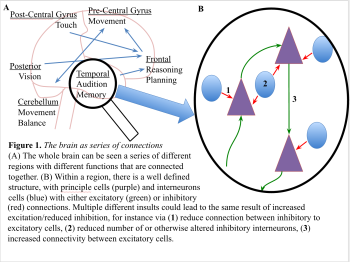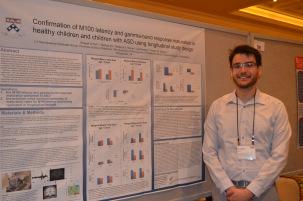By Russell Port
While the symptoms of ASD are well known, the changes in the brain that cause these disorders still remain a mystery for scientists. In an attempt to understand the neurological differences of someone on the autism spectrum, scientists have looked at brains from multiple angles, from within single cells to how large parts of the brain communicate with each other.
The brain can be considered a series of circuits that connect different sub-types of cells; when properly aligned, these circuits allow for healthy neural activity (Figure 1). Due to the complexity of neural connections, multiple different types of alterations to cells can produce similar consequences in neural functioning, either through turning off activity or turning on activity so cells can talk to one another. In fact, one of the many things that cause autism is an imbalance of too much activity vs. too little activity of brain cells during critical periods of development when brain cells rely on each other to develop. This imbalance would affect the way neurons communicate. One way communication is affected is with special brain waves as known as “gamma oscillatory activity”. We see this in the clinic, where people with ASD exhibit less gamma-band activity in response to numerous stimuli, including faces, while more gamma-band activity at rest.
Figure 1

Recently, we suggested a new approach to understanding these neural circuits (Port, Gandal, Roberts, Siegel, & Carlson, 2014). This approach starts with parts of this neural circuit and progresses up to look at activity of the whole brain – translating findings found in an animal model up to people with autism. In this article, we suggest that brain waves are the ideal way to allow researchers to study a similar measure across different types of studies. For example, brain activity could be the common language the ties together animal model research with studies of treatments. This translational approach is critical to understanding the potential role of genetic and cellular changes that are suggested by studies of ASD. In other words, by looking at brain waves reflecting core circuit function, whether by imaging voltage changes in brain slices, direct electrode recording, EEG or MEG, we see promise in integrating the multiple different insults seen in ASD into common circuit effects.
Being a pre-doctoral fellow for the ASF has helped support world-class mentorship in neuroscience research and began my career as an autism research scientist. I was given the opportunity to form a research project under the guidance of two mentors, both of whom are leaders in their respective fields. Together we have created a new research project that crosses back and forth between human and animal studies, letting the findings from one inform other. We are publishing work suggesting that neural circuits are potentially a key region of integration for all the different changes seen in ASD. By looking at the function of these neural circuits, we can study the same entity in animals as we measure in people with ASD. This approach is crucial to making sure that discoveries in the lab turn into treatments in a clinic.

Russell Port presenting at IMFAR
- Port RG, Gandal MJ, Roberts TPL, Siegel SJ, Carlson GC. Convergence of circuit dysfunction in ASD: a common bridge between diverse genetic and environmental risk factors and common clinical electrophysiology. Frontiers in Cellular Neuroscience; Dec 8 2014. (8): 414.
